PinotFile: 8.1 September 19, 2009
|
DEHLINGER: Russian River Valley StalwartThe year was 1973. Russian River Valley Pinot Noir was in its infancy. Joseph Swan, who had planted Pinot Noir in the Vine Hill region of the Russian River Valley four years prior using cuttings from Mount Eden and budwood from Burgundy, released his first Pinot Noir. Davis Bynum, working out of an old hop mill on Westside Road, released his 1973 Rochioli Vineyard Russian River Pinot Noir, the first vineyard-designated wine from the Russian River Valley. Russian River Valley Pinot Noir was beginning to happen and into this stage came another visionary, Tom Dehlinger, who, along with his radiologist father, invested in a 45-acre ranch on Vine Hill Road in Sebastopol. Tom Dehlinger (DAY-leen-ger) was born on the East Coast, but grew up in Berkeley, California, and earned a degree in biochemistry at University California Berkeley. He pursued graduate work in enology and food science at University California Davis for a year, leaving school to work in the wine industry, first as a lab technician at Beringer, then in winemaking positions at Hanzell and Dry Creek Vineyard. He was only 26 years old when, in 1973, he set upon a career as an independent winegrower and winemaker. He met his future spouse, Carole, a few years later, married her in 1978, and she was to become an important contributor to the success of Dehlinger. Early on, Tom had a well-defined idea of how wine grapes should be grown, and realizing that other grape farmers were not conforming to his vision, he was driven to plant his own vineyard. He spent the spring of 1974 bench grafting and callusing over 10,000 vines in a rented heated basement room in Bolinas in Marin County. By summer, Tom had planted the fledgling vines in a nursery space in Dry Creek Valley. At the same time, he was removing Gravenstein apple trees from his neglected hillside property which had previously been a source of noteworthy Zinfandel at the turn of the century. With guidance from Joseph Swan, Warren Dutton and Forrest Tanzer, Tom planted the first 14 acres of vines on his property in the spring of 1975.
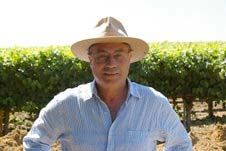 The Dehlinger property is located in southwestern Sonoma County, four miles north of the town of Sebastopol at the intersection of Gravenstein Highway and Vine Hill Road in the Russian River Valley appellation. Tom knew the importance of terroir and choose this particular site in the Laguna Ridge area of the Russian River Valley because of its climate and soils. The site is cool, heavily influenced by maritime fog and receives significant diurnal variation in temperature. The soil is Goldridge type consisting of fine sandy loam and a variant of Goldridge known as Altamont, which is composed of gravelly fine sandy loam with a sandy clay loam subsoil underlain with sandstone. Grapes thrive in these soils, which are well-drained and somewhat lacking in nutrients. The original 1975 Dehlinger Pinot Noir 4-acre plantings were UCD 4 (Pommard) and UCD 13 (Martini) with a smaller selection of cuttings from Joseph Swan’s vineyard which was also planted on Goldridge soil in a nearby section of Laguna Ridge. Chardonnay (8 acres) and Cabernet Sauvignon (2 acres) completed the initial planting. Cabernet Franc, Merlot and Syrah were later additions. The original 4-acre Pinot Noir block consisted of two acres of Swan selection and two acres of mixed clonal origin, part Pommard and part Martini. After a few years, it was evident that the three clonal types were quite different in their growth patterns and therefore were eventually picked and processed separately. In addition, significant soil differences within the vineyard were recognized and the soil distribution of the vineyard was mapped and vine stakes painted to indicate soil type. The lower elevations of the vineyard had Goldridge soil which was deeper, richer and more fertile. The hilltops contained Altamont soil, a variation of Goldridge with a redder color, different mineral content and low vigor. Irrigation in different parts of the vineyard was customized according to soil type and vigor. In recognizing differences in terroir within the vineyard, Tom became an early champion of separately picking and vinifying small lots of grapes from different portions of the vineyard. The original vines were planted on AxR1 rootstock using 10‘ x 8‘ spacing which was in vogue at the time. Irrigation was achieved with overhead sprinklers. The vines were trained on a single wire and pruned to two fruiting canes. It was soon evident that vine growth was too vigorous and drooping. The vines lacked balance, particularly on the lower elevations with the growth of leaves far outstripping fruit production. The result was vegetal flavors in the finished wines. For many years, all the vineyard work at Dehlinger was performed by Tom and Carole and one or two field workers. In 1988, Marty Hedlund, who had a horticulture degree from Washington State University, was hired as vineyard manager. Hedlund supervised the planting of the last one-third of the land, bringing total plantings of Chardonnay, Pinot Noir, Syrah and the three Bordeaux varieties (Cabernet Sauvignon, Merlot and Cabernet Franc) to close to 50 acres. He also instituted a program to overcome the vine imbalances in the Dehlinger vineyard. A new split-canopy vertically shoot-positioned Lyre trellis system derived from Bordeaux was retrofitted by 1993, converting 37 of the acres (photo below in 2008). This movable trellis lifted shoots and leaves up and away from the bank of grapes allowing more light exposure, permitting more precise hand work to manage the shoots and clusters during the growing season, reducing the risk of mold and mildew, and permitting the vine and grapes to dry out quickly if rain occurred before harvest. By 1997, a crew of four managed the vineyard full time with an additional four workers from May to October. The dedicated farming created a vineyard that displayed, according to Tom, “A level of vine care unmatched in intricacy in Sonoma County.” Noted viticulturist, Dr. Richard Smart, was to say at the time, “The Dehlinger Vineyard is one of the best examples I’ve seen anywhere in the world of careful vineyard management with the aim of maximizing quality.”
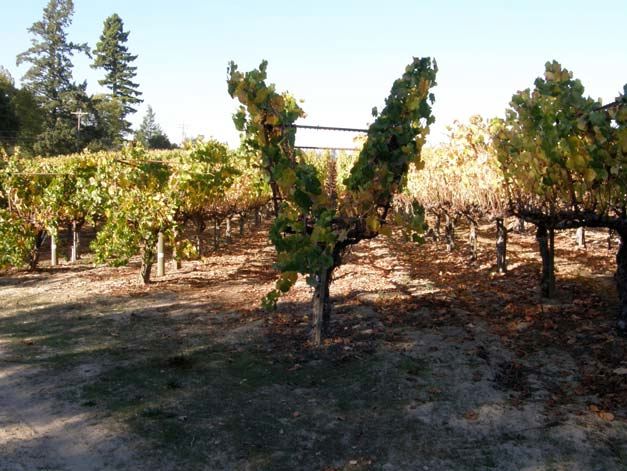 Pinot Noir acreage currently stands at 16, consisting of 5.5 acres of Swan selection, 8.5 acres of Pommard clone, 1 acre of Martini clone and 1 acre of Dijon clone 777 obtained from neighbor Steve Kistler in 1996 and grafted onto Cabernet Franc. Of the 16 acres of Pinot Noir, 5 acres are planted in the lower parts of the vineyard in Goldridge soil (referred to as the Goldridge Vineyard) and 11 acres are in hilltop areas featuring Altamont soil. The fruit from the low-lying part of the vineyard was not originally as good qualitatively as fruit from the hilltop sections. An inexpensive wine was made from this fruit before 1993 and labeled “Lot #2,” which also included second crop grapes. By 1993, the grapes had benefited from careful vine work and the new trellis system, and the grapes from the low-lying portions of the vineyard were bottled as Dehlinger Goldridge Vineyard Pinot Noir. Paul Root, a long time wine retailer in Healdsburg, who sold Dehlinger’s first vintage and placed Tom’s wines in local Safeway stores in the late 1970s and early 1980s, tells a humorous story about the origins of the Goldridge Vineyard Pinot Noir. Tom had two barrels of Pinot Noir that vintage that were not up to the level of the primary estate bottling. He called Paul and asked him to taste the wine, saying that he would custom bottle it for Paul’s store. Paul couldn’t taste that day because a baby sitter could not be found. Tom called him later and said he decided to bottle the wine as Goldridge Vineyard Pinot Noir. Over the years, the quality of this wine has improved dramatically and Tom has stated, “Neither the Goldridge nor the Estate Pinot Noir is inherently superior to the other.” Critics and consumers alike sometimes prefer the Goldridge Vineyard bottling over the Estate bottling. A special 3.5-acre plot of Swan selection was planted in 1982 around the original octagon-shaped house on the top of the property. This site is referred to as Octagon Vineyard. The 900-square-foot eight-sided house (photo below) was built in 1975-76. Tom lived with 3 children in this tiny house but was to later move. The house on Octagon Hill has become a Russian River Valley landmark. Since the inaugural vintage in 1994, when the quality warrants, Dehlinger releases a limited amount of Octagon Pinot Noir. In other years, the fruit from this vineyard is included in the Estate or Reserve bottling.
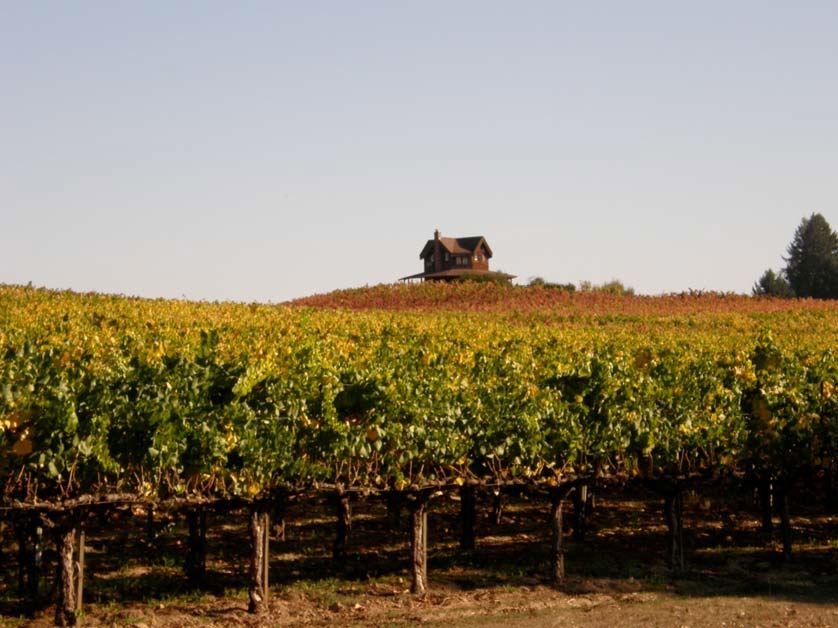 Another special part of the vineyard planted to Pommard clone in 1982 gave birth to the Dehlinger High Plains bottling starting with the 1999 vintage. Tom describes this quiet part of the vineyard a place of contemplation. He said that during one of his many visits to this quiet retreat, “I must have imagined I was Clint Eastwood riding alone as the High Plains Drifter and the name just stuck.” The Dehlinger Vineyard is one of the very few in the Russian River Valley and the only one in the cooler southern part of the Russian River Valley AVA that grows Cabernet Sauvignon. Dehlinger admits that farming Cabernet Sauvignon here in some vintages has been very challenging but some vintages have produced superb wines that have been highly lauded by the wine press. From 1992 thru 1997 a Bordeaux Blend bottling was produced, but the Merlot in the vineyard was grafted to Chardonnay and the Blend was discontinued to concentrate on Cabernet Sauvignon alone. A small amount of Syrah continues to be produced. Tom made his first wines in 1975 in rented space at Joseph Swan’s winery on Laguna Road. His first vintages were crafted from purchased Chardonnay, Cabernet Sauvignon and Zinfandel. Tom’s brother, Dan, built the original Dehlinger winery on the vineyard property in 1975-1976. The first commercial wine from Dehlinger estate grapes was vinified here in 1977, and ever since, the emphasis has been on estate grown wines. Production has increased slowly from less than 1,000 cases in 1983 to 7,000 to 8,000 cases per year of Chardonnay, Pinot Noir, Pinot Noir Rosé, Syrah and Cabernet Sauvignon. Some estate grapes are sold to other producers. Despite the high demand for Dehlinger wines, Tom has steadfastly refused to increase production beyond present levels. Don Baumhefner, a veteran winemaker in Sonoma County who worked at Joseph Swan Winery for several years, also worked at Dehlinger for a short period during the early years. He recounted some humorous tales to me. He remembers one day when Tom and his brother, Dan, were working at Swan’s winery. “The day was highlighted by a test between Tom and his brother. They each tried to lift just-washed barrels over their head. No one died, but I can’t remember who won!” When Don worked at Dehlinger, he kept his children in an expandable playpen in the middle of the winery and Don’s son, Max, took his first steps in the winery. For relaxation, Tom and Don would use open-top redwood fermenters as hot tubs. Don has the utmost respect for Tom and told me, “Tom was a real no-nonsense winemaker. No frills, just honest, clean wines.” Winemaking at Dehlinger has evolved through the years. Fred Scherrer was an assistant winemaker at Dehlinger from 1988 to 1997. He was a strong advocate of reducing or eliminating red wine filtration and Dehlinger’s wines have not been filtered since 1995. Scherrer also helped develop the Dehlinger style by employing longer hang times and longer periods of maceration in the fermenter. By 1997, the popularity of Dehlinger wines had reached a pinnacle and the tasting room, which by then had little wine to offer visitors, was closed, the futures program was discontinued, and the mailing list topped out at 2,000 customers. At the end of 1997, there were over 1,000 names on a waiting list. Robert Parker, Jr., gushed about Dehlinger in the June 30, 1996, edition of the Wine Advocate: “Given the consistently high quality that emerges from this winery, owner/winemaker Tom Dehlinger might be the least intrusive and most humble winery owner I have met with. In a profession often dominated by towering, over sized egos, Dehlinger seems totally content to let his wines do the talking..........Dehlinger’s wines have consistently received laudatory reviews, but the quality level appears to have been pushed higher over recent years. Moreover, these wines remain among the most modestly priced, especially for a superstar California winery.” James Laube, writing in his book, California Wine (1999), said, “When it comes to Dehlinger’s wines, the advice is simple: If you see his name on a wine bottle, buy it.” Several years later, noted wine writer, Matt Kramer, wrote in New California Wine (2004), “Dehlinger wines represent an impeccable standard regardless of vintage.” Upon Scherrer’s departure, Eric Sussman joined Dehlinger as an assistant winemaker after six years of experience making wine in Washington State and France. He was the associate winemaker from 1998 to 2001. Tom Klassen was the enologist at Dehlinger from 2005 to 2008. The current winemaking regimen is outlined as follows. Each one-fourth to one-half-acre subsection of the vineyard is fermented and aged separately for the first 6 to 10 months and is then either blended or directed to distinct single bottlings for additional 6 to 18 months of bottle age before release. Grapes from the low-lying portions of the vineyard go primarily into the Goldridge Vineyard bottling, while the superior grapes from the hilltop sites go into the Estate or specially designated bottlings (Reserve, High Plains, Octagon). 5% to 30% whole clusters are included, depending on the vintage and the source of grapes within the vineyard. After a period of cold soak, all punch downs are performed by hand in open-top fermenters. A small amount of clear juice is bled off after placement of the grapes in the fermentation tanks. This is to increase color concentration and flavor intensity. The press wine is sold in bulk because it lacks the color and aromatic projection of free run juice.
The very personal biannual newsletters written by Tom Dehlinger contain a wealth of information, not only about Dehlinger wines, but the basics of winegrowing and winemaking. In the February 2001 newsletter, Tom wrote the most lucid explanation of punch downs that I have ever read. “The work of punching is one of the keys to making a rich and robust red wine. All the color and many of the flavor elements of a red wine are in the skins of the grapes, and these elements must be extracted into the initially colorless juice during fermentation. If crushed red grapes were left to ferment on their own without attention, the result would not be as appealing. The skins would be lifted upward by the evolving fermentation gasses and have little contact with the bulk of the juice below. They would also support faster microbial growth and develop an excessive amount of heat which could lead to spoilage. All red wine fermentations need some means of periodically mixing the rising skins (called the “cap”) and the juice to equalize the temperature and promote the extraction process. The hand punching method, which we have used exclusively since 1975, involves positioning oneself on a stepladder next to the tank and pushing down on the rising skins with a wooden disk attached to a hoe handle. The aim is to turn over the entire tank so that skins which had been on top are revolved to the bottom and vice verse. Servicing each tank takes about ten minutes and is done two to three times daily.”
In 2001, the Dehlinger winery began a major upgrading which included the creation of an underground cellar for natural cooling which can hold 15,000 cases of wine. The project was directed by Tom’s brother, Dan, who, by then, was a licensed architect. Seven separate temperature-controlled spaces are now available allowing the winery to hold back wine for re-release when the wine is in its prime (Each year in the first week of January, Dehlinger releases for sale on the website library wines that have aged 3 to 5 years). In the fall of 2008, one-third of the original 14 acres of vines were removed and a chipper was used to return the vine trunks to the soil. The soil will remain fallow for two years during which time it will be treated with organic compost and annual crops to rejuvenate it. The plantings to follow will be on low-vigor rootstocks, will be trained closer to the ground with 6’ to 7’ row spacing and 4’ between the vines creating a vineyard with three times as many vines as before. A single vertical shoot positioning trellis will be used. As each new section of the vineyard begins production, older sections will be removed and reborn as part of an ongoing process. Over the nearly 35 years that Dehlinger has produced wine, quality and consistency have been the hallmarks. This stalwart winery has never wavered from the vision upon which it was founded. The emphasis has always been on quality and Tom never pushed volume or prices. During the eleven vintages from 1996 to 2006, the Dehlinger Estate Pinot Noir had a modest price increase from $32 to $48. The simple label has remained unchanged and Dehlinger has never resorted to heavy bottles to glamorize the wines. Today, 80% of the wine is sold through a faithful following on the mailing list with small amounts distributed to long time restaurant and retail store customers (I have seen the wines at Bottle Barn in Santa Rosa). Some wine is held back every year, to be released as library wines each January as noted above. There still is no tasting room, but visitors are welcome for tours and tasting by appointment on Fridays from January through August conducted by Tom’s daughter, Carmen, and visitors may be offered some wines for sale if available (707-823-2378). A winery open house is held both in the spring and fall. The website is www.dehlingerwinery.com and the address is 4101 Vine Hill Rd, Sebastopol, CA. You may not get the chance to meet Tom, for although he is a personable guy, he is fiercely independent and private, akin to his winery business colleagues in the Russian River Valley, Tom Rochioli and Gary Farrell, and shuns the public eye. Recently, I conducted two tastings of Dehlinger Pinot Noir with three Pinot-loving friends who supplied some of the wines. On August 14, 2009, a vertical of Dehlinger Goldridge Vineyard Pinot Noir, 1998-2006, was tasted and the following week, on August 22, 2009, a vertical of Dehlinger Estate Pinot Noir, 1996-2006 (no 1997) was enjoyed. Special bottlings were also sampled including 1988 Dehlinger Lot #2 Pinot Noir, 1990 Dehlinger Lot #2 Pinot Noir, 1999 Dehlinger Octagon Vineyard Pinot Noir, 2000 Dehlinger Reserve Pinot Noir, and 2001 Dehlinger High Plains Vineyard Pinot Noir. The wine reviews are primarily mine with a few comments included from other tasters on a few of the wines. The two verticals consisted of wines that had been perfectly cellared since release. The provenance of the Lot #2, Reserve and High Plains wines were not known as they were acquired on the secondary market. Dehlinger Goldridge Vineyard Pinot Noir These wines were uneven in quality with the last three vintages (2004-2006) technically more sound and fresh. All wines retained a moderately deep reddish-purple color. The tasting group did not consider any of the wines exceptional with the 2004, 2005 and 2006 vintages being clearly the group’s favorites among the young wines and the 1998 vintage the best by consensus among the older wines.
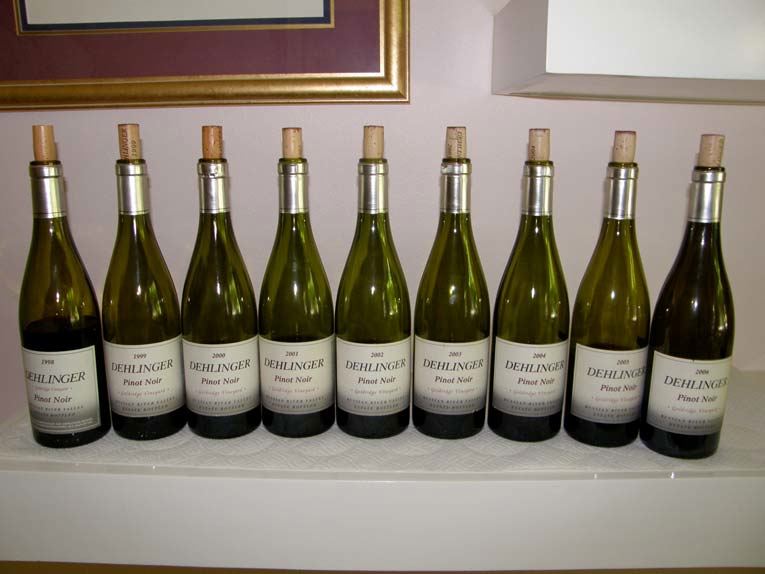
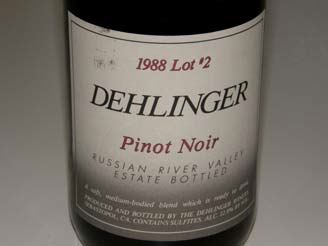 1998 Dehlinger Goldridge Vineyard Russian River Valley Pinot Noir 14.2% alc.,1,100 cases, $32. · Slight orange tinted rim. Surprisingly fresh initially with appealing aged Pinot Noir flavors of spiced cherries, brown spice and brown sugar. One taster noted minimal Brett on the nose. Very enjoyable initially, fading over three hours.
1999 Dehlinger Goldridge Vineyard Russian River Valley Pinot Noir 14.3% alc., 1,290 cases, $35. · Aromas of raspberries, cherries with a hint of oxidation. On the palate, pleasing and savory berry and black cherry flavors with a slight grilled fruit and citric note. The wine died quickly in the glass.
2000 Dehlinger Goldridge Vineyard Russian River Valley Pinot Noir 14.5% alc., 1,340 cases, $35. This vintage was softer, less weighty and more succulent early. · Vivid scents of berries and cherries with a floral note. Moderately rich with a tasty core of berries finishing with a tang and some persistence. Still showing some tannin but time to drink up. Faded slowly over three hours.
2001 Dehlinger Goldridge Vineyard Russian River Valley Pinot Noir 14.3% alc., 1,600 cases, $35. · Slightly oxidized with aromas of soy and forest floor, and flavors of roasted fruit and nuts and raisins. Unappealing.
2002 Dehlinger Goldridge Vineyard Russian River Valley Pinot Noir 14.6% alc., 1,300 cases, $35. Aged in 50% new French oak barrels (usually 35%). · Full-on attack of cherries, berries and spice on the nose. Slightly confected and flat rich fruit flavors with a citric peel tang on the finish. A green bean taste intruded over time.
2003 Dehlinger Goldridge Vineyard Russian River Valley Pinot Noir 14.4% alc., 1,300 cases, $36. Aged in barrel 16 months. · Just can’t get past the nose on this wine. While there are some pleasant blueberry and cranberry fruit aromas, there is also a strong smell of tequila. Soft in the mouth with supple tannins and restrained flavors of raisined berries.
2004 Dehlinger Goldridge Vineyard Russian River Valley Pinot Noir 14.9% alc., 1,300 cases, $39. · Pure and bright raspberry aromas with a hint of graham. Propelled by the alcohol, the rich fruit has a sweet fullness and lengthy persistence on the finish. Packed with pleasure, but retaining an elegance with gossamer tannins and pleasing acidity. A very good drink.
2005 Dehlinger Goldridge Vineyard Russian River Valley Pinot Noir 14.5% alc., 1,250 cases, $40. · This is a very age worthy wine that is richly endowed with Pinot fruits and still retaining noticeable oak and tannin. Very smoothly textured and light on its feet. The most harmonious wine in the lineup. Can drink now for its fruity youthfulness, but will go another 6-8 years.
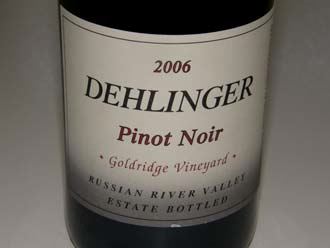 2006 Dehlinger Goldridge Vineyard Russian River Valley Pinot Noir 1,600 cases, $44. · Great scent of raspberries, cherries, cola and a hint of oak.. Spicy, tenacious palate of mouth coating cherries and cranberries with a sidecar of oak. Lovely depth with an appealing restraint, featuring a soft, smooth mouthfeel. Pretty damn good.
Dehlinger Estate Russian River Valley Pinot Noir All the wines had a moderately deep reddish-purple color, bright acidity, and a sweet fullness from the moderately high alcohols. Impressive for their consistency, these wines are a step above the Goldridge Vineyard in complexity, finishing persistence and age ability. I would be happy to drink any of the wines today, but if I can find any of the 2004 vintage, I am buying all I can get my hands on.
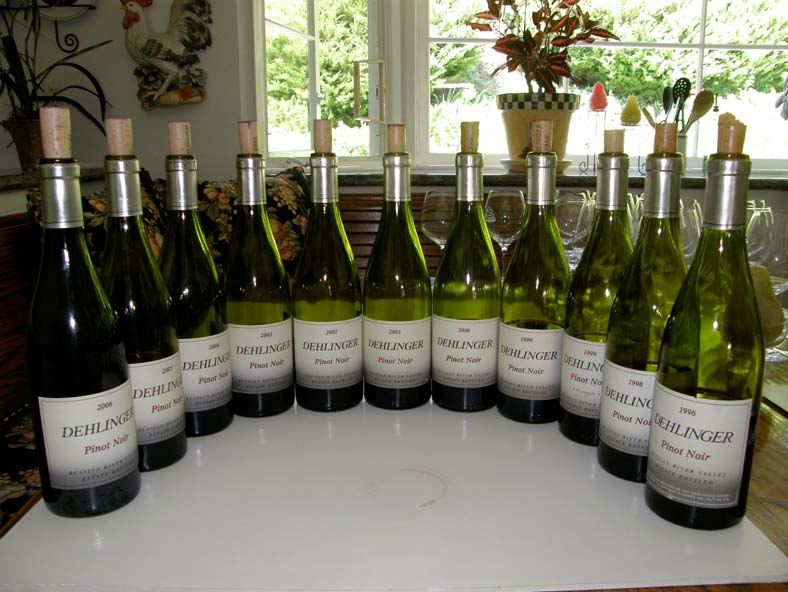
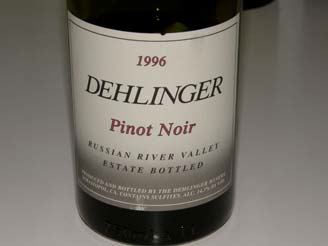 1996 Dehlinger Estate Russian River Valley Pinot Noir 14.5% alc., 990 cases, $32. Low yields in this vintage. Aged 20 months in French oak. · Slightly cloudy with an orange-brown tinge to the rim in the glass. Wonderful secondary bouquet of plums, blackberries, mushrooms, forest floor and cigar box. Dark fruited and only slightly faded with a background of earth, oak and anise. Still drank well two hours after opening. Impressive.
1998 Dehlinger Estate Russian River Valley Pinot Noir 14.5% alc., 1,050 cases, $40. · Darkly colored with a slight orange tinge to the rim in the glass and a mild haziness. Plenty of barnyard initially which blows off revealing aromas of black raspberries and blackberries. Rich and full-bodied, dark fruit driven, with some fading and flatness to the fruit profile and a short finish.
1999 Dehlinger Estate Russian River Valley Pinot Noir 14.8% alc., 1,260 cases, $42. · Slight haziness in the glass. Lovely scent of red plums, raspberries, vanilla and cream soda. More acidity in this wine allowing it to drink fresh and young with an appealing core of fresh berries underpinned with a citric tang. Very good.
2000 Dehlinger Estate Russian River Valley Pinot Noir 14.6% alc., 1,600 cases, $40. A cool growing year with a record crop. Sourced from Altamont soil series only. · The nose draws you in with a perfume of crushed Bing cherries, raspberries and cola. Lovely depth and richness of flavor with plenty of sweet, fresh, vivid fruit and a deft touch of oak. A very pretty wine that is drinking perfectly now. One to dance with all night.
2001 Dehlinger Estate Russian River Valley Pinot Noir 14.4% alc., 1,300 cases, $40. · Darker red fruits and marzipan mark the aromas and flavors. A bigger, darker wine than 2000 with copious sweet fruit and a remarkably persistent finish. Starting to fade 2 hours after opening.
2002 Dehlinger Estate Russian River Valley Pinot Noir 14.7% alc., 1,300 cases, $40. Includes High Plains section of vineyard. · Sweet scented nose of dark berries and green garden. On the palate, the generous fruit tastes of mu shu plum sauce. The tannins are supple and the whole package is very harmonious. This wine didn’t illicit emotion, but is very solid and holding up nicely.
2003 Dehlinger Estate Russian River Valley Pinot Noir 14.4% alc., 1,300 cases, $42. Octagon and High Plains sections of vineyard included. · Very floral nose with overtones of tequila. The flavors trump the nose with a rich parade of full-bodied dark red fruits that are smoothly textured and framed by reigned-in tannins. My least favorite of the vertical tasting.
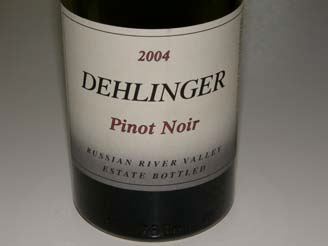 2004 Dehlinger Estate Russian River Valley Pinot Noir 14.9% alc., 1,150 cases, $45. · Complex nose with the scent of freshly crushed berries accompanied by notes of cherries, toast, brioche and spice. Mouth coating blue and black fruits that find every nook and cranny in the mouth linger on the finish for what seems like a minute. Notes of cherry cola and sassafras add interest. A very hedonistic, yet caressing wine. The alcohol is well balanced by harmonious t n‘ a. Still drank great a day later from a previously opened re-corked bottle predicting a long life ahead. This wine makes you want to clap your hands.
2005 Dehlinger Estate Russian River Valley Pinot Noir 14.6% alc., 850 cases, $45. Low yields due to poor set so no reserve or special bottlings this vintage. · Bright berries, cherries and vanilla cream on the fresh nose. Earth-kissed fruits on the palate showing youthful exuberance with a touch of sweet oak. The texture is very polished. Still drank fine the next day from a previously opened re-corked bottle.
2006 Dehlinger Estate Russian River Valley Pinot Noir 14.9% alc., 1,300 cases, $48. A blend from three of the four hilltop locations (omitting the High Plains). · Still very young and unyielding. Swirling the wine brings out scents of earthy dark red fruits, smoke and dark mocha. Richly fruited with a moderate tug of dry tannin. The earthiness of the wine trumps the fruit at this stage. After 2 hours, the wine begins to blossom with expanding flavors of savory fruit and a touch of spice. A wine to cellar for now, knowing but that it has tremendous future potential.
 1988 Dehlinger Estate Lot #2 Russian River Valley Pinot Noir 12.9% alc. $50 (current secondary market). · Slight brick color to rim. Very nice aromas of black cherries, seasoned oak, toast and leather. Tart cherry and cranberry flavors displaying a faded, earthy character. Lingering grapefruit peel on the finish with minimal tannins. Some charm but the fruit is diluted and the acidity has come to the forefront.
1990 Dehlinger Estate Lot #2 Russian River Valley Pinot Noir 13.5% alc. $50 (current secondary market). The back label says, “A soft, medium-bodied blend which is ready to drink.” · Still retaining good color with a very slightly brick-colored rim in the glass. Charming nose of cherries, cinnamon spice, sandalwood, aged oak and cigar smoke. Roasted cherry and cherry cola flavors with notes of berries and tobacco. The tannins are completely resolved with some mild persistent acidity. Soft and smooth in the mouth with a touch of astringency on the finish. Some interest and surprisingly respectable longevity.
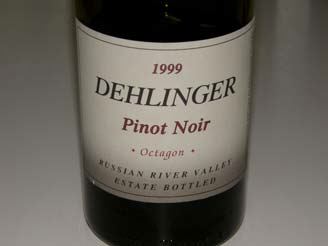 1999 Dehlinger Octagon Russian River Valley Pinot Noir 14.6% alc., $50. Aged 18 months in French oak. · Slightly hazy in the glass. A gorgeous wine in all respects that is drinking perfectly now. Attractive aromas of mixed berry and cherry jam that make you want to go on sniffing. Juicy and succulent, darkly fruited, with that appealing Pinot sweetness. Nuanced flavors of cola, tea and truffle. The well-endowed tannins are fine-grained and the finish is ridiculously long. A ten-year-old wine that has aged beautifully and is special in every way.
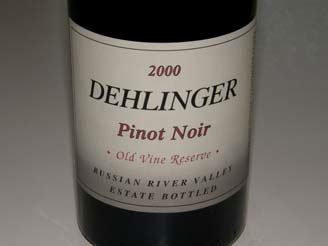 2000 Dehlinger Old Vine Reserve Russian River Valley Pinot Noir 14.6% alc., 430 cases, $30. · Demure scents of cherries, herbs and faint oak. Very tasty cherry core with an appealing earthiness flanked by baking spice ending with a citric tang on the finish. Not intense like so many reserve bottlings, rather offering more charm and sophistication. Plenty of finesse and proper t n’ a to last another 3-4 years. Lovely age related patina with fruit flavors that have been seemingly simmered for several years. A wonderful wine.
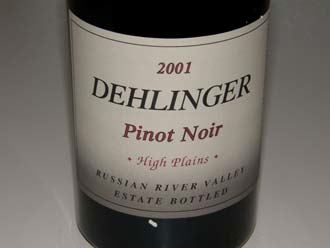 2001 Dehlinger High Plains Russian River Valley Pinot Noir 14.5% alc., 225 cases, $48. Sourced from 13 year old Pommard vines. · Delicate scents of cherries, spice, oak and green garden. Delicious cherry core with a slight fennel note that is complimentary. This wine has that Dehlinger restraint - an elegance that makes Pinot Noir so appealing. The wine is still holding enough structure to last another five years. A terrific wine that could stand up to any 2001 1er Cru Burgundy.
Summary: Drink the Dehlinger Goldridge Vineyard Pinot Noirs with family and friends. Open the Dehlinger Estate Pinot Noirs with special friends and Pinot geeks. Drink the special Dehlinger bottlings when you want to share an evening of romance with your spouse or special friend.
The following information was obtained from the biannual Dehlinger newsletters and is not complete.
1993
1994
1995
1996
1997
1998
1999
2000
2001
2002
2003
2004
2005
2006
2007
Olson Ogden WinesJohn Ogden and winemaker Tim Olson started a boutique winery in the Russian River Valley of Sonoma County in 2002, making about 1,000 cases a year of Rhone varietals and Pinot Noir. Tim Olson began crafting wine in his home garage over 20 years ago. A film major in college, he developed enough of a passion for wine that to gain experience, he began working for free at Caymus for Charlie Wagner. Before long, he was rewarded with a paycheck for his hard work and he has never looked back. He made some excellent wines for Tarius before starting Olson Ogden Wines.
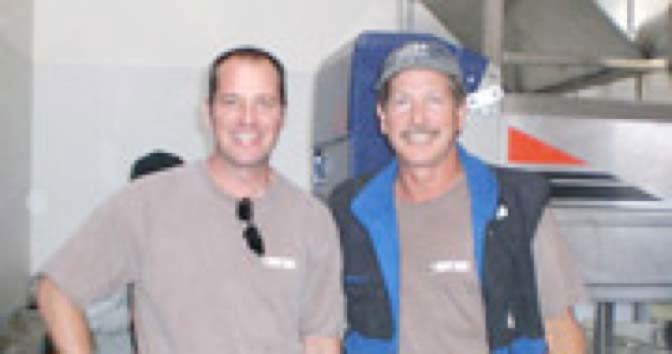 Pinot Noir named vineyard sources include Alder Springs Vineyard in Mendocino, Manchester Ridge Vineyard in the Mendocino Ridge AVA of Mendocino County, and Eastside Road Vineyard and Willowside Vineyard, both in the Russian River Valley. The first harvests for Olson Ogden Wines from Alder Springs Vineyard and Manchester Ridge Vineyard were 2008, so these wines will not be released until 2010. Olson Ogden has gained some national press recognition for their Unti Vineyard Syrah, but the recently released 2007 Pinot Noirs from the Russian River Valley and Sonoma Coast indicate the winery is equally accomplished with Pinot Noir. These are the two best Pinot Noirs I have sampled from this producer. Both are excellent food wines.
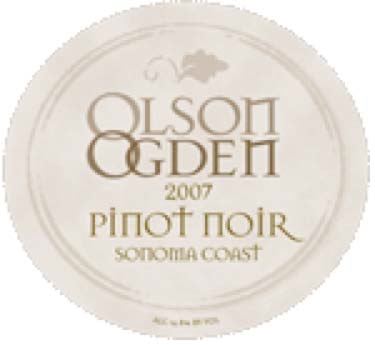 2007 Olson Ogden Sonoma Coast Pinot Noir 14.8% alc., $32. Most of the fruit is from the Petaluma Gap of the Sonoma Coast. Clones 115 and 667. A small amount of the blend comes from the winery’s two Russian River vineyards. Aged 17 months in 57% new French oak. · Reserved, almost mysterious aromas and flavors of earthy dark red fruits with a hint of toasty oak. The tannins are nicely reigned in and the mouthfeel is very soft and silky. A harmonious wine that can be enjoyed now, but has the structure to gain expression and interest with another 6-12 months in the bottle.
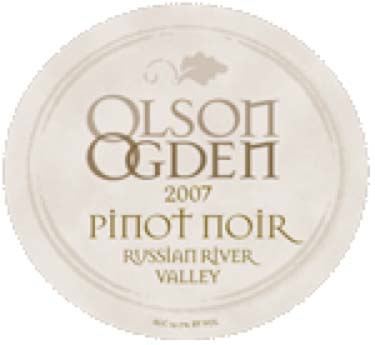 2007 Olson Ogden Russian River Valley Pinot Noir 14.7% alc., $42. Martini clone from Eastside Road Vineyard and UCD 23 clone from Willowside Vineyard, both in the Russian River Valley. Aged 17 months in 44% new French oak. · Intense Bing cherry and cola aromas with a hint of herbs and oak. Delicious medium-weighted core of dark red cherries and berries supported by gentle tannins and fine acidity. A strikingly polished wine with a velvety presence in the mouth and a lingering fruity finish. Quintessential Russian River Valley Pinot Noir. I can’t say enough good things about this terrific wine.
Olson Ogden Wines are sold through a mailing list at www.olsonogdenwines.com. There is some retail distribution. The phone is 707-823-6127.
Small Sips of Pinot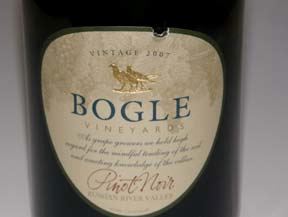 2007 Bogle Vineyards Russian River Valley Pinot Noir 14.2% alc., pH 3.62, $13, released March, 2009. From a family owned winery in Clarksburg, CA producing multiple varietals from its Delta vineyards, but having a good track record with value priced Pinot Noir as well. Aged 12 months in French and American oak. · A pretty solid wine for the fare featuring a rich core of black cherry and black raspberry fruit with underpinnings of exotic spices, dark chocolate, and smoke. The tannins are restrained and the finish is pleasingly fruity albeit a touch hot. Widely distributed.
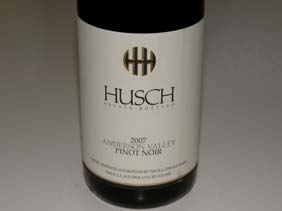 2007 Husch Vineyards Anderson Valley Pinot Noir 13.9% alc., $17. Aged 9 months in French oak. · Moderately deep garnet color. Red fruits including strawberries and raspberries are featured in the aromas and flavors in a lighter-weighted style with a touch of savory herbs in the background. An easy drinker with gossamer tannins and a soft mouth feel. A consistently reliable producer of value-priced Pinot Noir. Available on the website at www.huschvineyards.com and through fine retail wine stores.
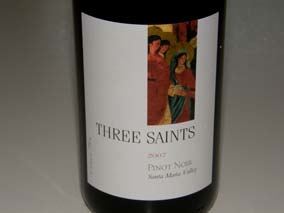 2007 Three Saints Santa Maria Valley Pinot Noir 14.5% alc., pH 3.45, $24, screw cap. Dierberg Winery produces three tiers of Pinot Noir from the Santa Maria Valley Dierberg Vineyard. The Three Saints bottling is meant for early approachability and near-term enjoyment. The name comes from the 3 Saints - Maria, Rita and Ynez - representing three dynamic wine grape producing areas of Santa Barbara County. Grapes are de-stemmed but not crushed. Aged in 12% new French oak for 17 months, lightly fined and bottled without filtration. 100% Pinot Noir. · Very dark violet color. Fabulous nose with considerable interest. Aromas of plum sauce, black raspberry and blackberry, cardamon spice and white pepper. Darkly fruited with a touch of oak, earth, beef, tar and Moroccan spice on the palate. Discreetly rich with soft, fine tannins and a fruit-perfumed finish. Very Caliesque and thoroughly enjoyable now. The wine has good retail distribution and is available online at www.threesaintsvineyard.com.
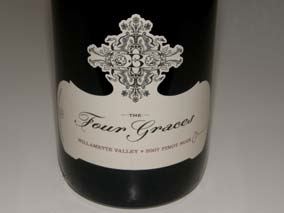 2007 The Four Graces Willamette Valley Pinot Noir 13.5% alc., 11,000 cases, $29. A popular restaurant wine. This is the winery’s value-play bottling sourced primarily from the Black Family Estate in the Dundee Hills AVA and Doe Ridge Estate in the Yamhill-Carlton AVA. Aged 10 months in French oak. The winemaker is Laurent Montalieu. · Not nearly as charming as the 2006 bottling. Silky and light in weight, the earthy fruit seems dilute and is dominated by oak throughout. I have been impressed with the wines from this producer and this may represent a bad bottle. This wine is widely distributed and sold on the website at www.thefourgraces.com.
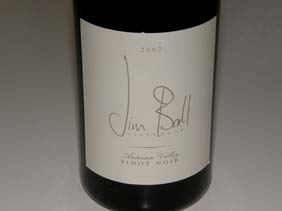 2007 Jim Ball Vineyards Signature Anderson Valley Pinot Noir 14.5% alc., $30. · Subdued but pleasant scents of black cherries and oak. The oak influence carries through on the palate. Decent cherry and berry tastes backed by savory herbs with a finish that is short and dry. Not up to the quality of the 2006 vintage bottling of this wine. The wines are sold through a mailing list at www.jimballvineyards.com with some retail distribution.
 2007 Mueller Emily’s Cuvée Russian River Valley Pinot Noir 14.8% alc., pH 3.60, 1,125 cases, $44. Sourced primarily from vineyards near the banks of the Russian River. Both inoculated and indigenous yeast ferments. · Hi-tone nose of flamboyant black cherry fruit with a touch of toasted bread and barnyard. Fat in the mouth with flavors of black cherries and red plums and an appealing earthiness. A good grip of acidity balances the full-bodied fruit nicely. Smoothly textured with plenty of length on the fruit-laden finish. Definitely worth a look. Sold primarily through a mailing list at www.muellerwine.com.
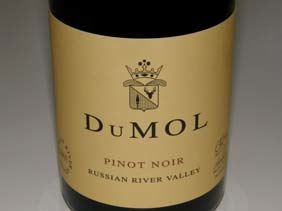 2007 DuMol Russian River Valley Pinot Noir 14.5% alc., $65. · Muted but pleasant aromas of cherries, grapes and a whiff of smoke. Luscious and discreetly rich cherry-berry compote on the palate. The fruit is crisp and juicy and accented with baking space. The wine gets better and better over time in the glass. Beautifully composed and well worth seeking out. DuMol wines are sold through a tightly allocated mailing list at www.dumol.com.
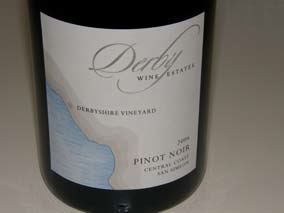 2006 Derby Wine Estates Derbyshire Vineyard San Simeon Central Coast Pinot Noir 14.8% alc., pH 3.75, 235 cases, $42. Inaugural Pinot Noir from this newer producer. The Derbyshire Vineyard is just 1.25 miles inland from the Pacific Ocean bordering the Hearst Ranch. 62 acres were planted in 2002 to Pinot Noir clones 115, 667 and 777 and Pinot Gris. Grapes are also sold to Tantara, Wind Gap Wines and Wild Horse. 50% whole cluster. Aged 18-20 months in 50% new French oak. Unfined and unfiltered. The winemaker is Tiffinee Vierra. · Deep reddish-purple color. Alluring scents of dark cherries, Moroccan spice and sage. Discreetly concentrated core of cherry and red plum fruit with overtones of herbs and vanilla and a tangy finish that lingers with a grapefruit peel note. The tannins are supple permitting easy drink-ability. Sold on the winery’s website at www.derbywineestates.com.
Pinot Briefs
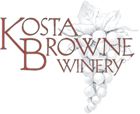 Kosta Browne Sold to Vincraft for $40 Million Vincraft has bought a controlling interest in Kosta Browne, a popular producer of Pinot Noir located in Sebastopol, CA. Reportedly, principals Michael Browne, Dan Kosta and Chris Costello wanted to pay off some of the original investors and acquire a new partner. Michael Browne will continue as winemaker, with Dan Kosta and Chris Costello remaining to manage the operation. The purchase price includes no vineyards or winery (Kosta Browne leases space in the Vacu-Dry plant on Highway 116 in Sebastopol). The price is astonishing but not unwarranted considering the success of Kosta Browne. The entire annual production of about 10,500 cases of Pinot Noir is quickly sold directly to eager mailing list members. Visit www.kostabrowne.com. New Organic Wine Labeling Law If a bottle of wine is labeled “Made with Organically Grown Grapes,” it must contain 100% organically grown grapes. If there are non-organically grown grapes in the wine, this must be stated on the label including percentages of organic and non-organic grapes. Japanese to Release Own Version of Sideways In October 2009, a new variation of the popular movie Sideways will be released in Japan. The movie was filmed in California and takes place in Napa Valley as the two male principals in the movie (Daisuke - Jack in the original movie) and Michio (Miles) celebrate the upcoming wedding of Daisuke to an American girl. The film relates the pair’s road trip from Los Angeles to the Napa Valley and is centered in Calistoga, which replaces Solvang in the original movie. Wineries included in the film are Darioush, Domaine Chandon, Frog’s Leap, Newton, and Lynmar. Some of the scenes from the original movie are reenacted such as the drinking from a tasting room spit bucket. Actor Paul Giamatti, who played Miles in the original movie, was asked to play a cameo role but declined. A website has been launched at www.movies.foxjapan.com/sideways_jpn/. Watch the trailer, its a hoot! Wine Preservation Systems May Not Be All They Claim Sunset magazine reported this year about an experiment conducted by the magazine to compare several wine preservation systems. They tested 54 bottles using three systems: Private Reserve (oxygen is removed and replaced by inert gas), VacuVin Wine Saver (oxygen is pumped out of the bottle), and a third system that involved simply pouring the wine into a smaller bottle and re-corking it. Bottles were also re-corked as controls. No difference was found among all the systems tested and some of the wines that had been simply left open were preferred over ones that had been subjected to one of the three preservation systems. Wine Tasting Room Openings Ferrari-Carano Vineyards and Dry Creek Vineyards have renovated and reopened the Seasons of the Vineyard Bar & Boutique tasting room located on the Healdsburg Plaza at 113 Plaza Street. The Seasons of the Vineyard is open daily from 10:00 AM to 6:00 PM. Pey-Marin Vineyards opened a tasting room at the Olema Inn and Restaurant in rural Olema, near Point Reyes National Seashore. Housed in a historic Victorian building, the tasting room is open from 12:00 to 4:00 daily. Bloggers Planting Own Vines Hahn Family Wines created a 1.6 acre “The Bloggers Block” in their Smith Vineyard in the Santa Lucia Highlands. Bloggers attending the Hahn Tasting and Planting Forum in May planted their own vine in the Bloggers Block under the direction of vineyard manager Andy Mitchell and Hahn Estates winemaker Paul Clifton. Other wineries are sure to follow, hosting bloggers for educational and planting events to enhance their outreach. For more information, visit www.winedivergirl.com.

SBC Celebration Of Harvest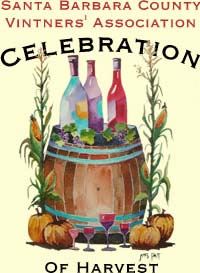 The annual Celebration of Harvest is held each October when winery staff need a break to present their latest wines. This year's Santa Barbara County Celebration of Harvest will be held on October 10, from 1:00 to 4:00, on the ground of the Rancho Sisuoc Winery in the Santa Maria Valley. Over 100 Santa Barbara County wineries will showcase their wines along with food from local restaurants, caterers and food suppliers. Live music will be provided by several bands and a Silent Auction of special wines will be held. Tickets are $65 each, $75 at the door. A related program, the Vintner's Visa, is a tasting pass ($35) good for 12 wineries and is held over 4 days, October 9-12. The wineries are offering barrel tastings, library selections and food and wine pairings. In addition, many wineries are offering their own open houses, luncheons, and dinners, such as the harvest BBQ at Melville, Tantara and Kenneth Volk Vineyards. Visit the website at www.sbcountywines.com for tickets and a complete listing of the four day events. The phone number is 805-668-0881.
2007: You’re The One That I WantThe economic slump has affected us all, and the prices of good Pinot Noir make it seem like Pinot Noir isn't so much a wine as a drink for the privileged few. The timing is unfortunate because the 2007 vintage Pinot Noirs from California are the best ever statewide. James Laube wrote in a recent issue of the Wine Spectator, “Now comes 2007, offering the greatest assortment of outstanding wines in the 25 years I’ve been tasting and writing about Golden State Pinot.” I echo his sentiments completely. The time to stock your cellar is now because the next two vintages will probably not provide the wide-ranging quality of the 2007 vintage. 2008 was a vintage from hell with many regions suffering severe frost at bloom, periods of intense heat, and smoke taint. The grapes from a number of vineyards were either not made into wine or the resulting wine was sold off in bulk. 2009 has presented its own challenges. I recently returned from harvest work in the Russian River Valley. The off and on heat has shortened the growing season for Pinot Noir. Grapes last week were reaching optimum Brix for picking, but were lacking in phenolic, seed and stem maturity. Harvest had been moved up 10-14 days in a number of warmer-sited vineyards. That said, 2009 should fare better than 2008. How can you make Pinot Noir your daily drinker, your house wine, without taking out a loan? Pinot Noir has ridden the Sideways wave to unprecedented popularity and prices have escalated in step, creating disdain in the minds of some wine drinkers. Fortunately, there are plenty of Pinot Noirs that are quite affordable and some of these can be very, very good. I have tried to feature a number of wines under $40, even under $20 that you can happily dance with. The task of choosing among the vast number of value-priced Pinot Noirs is challenging as evidenced by the 2,843 wineries in California, many of which produce Pinot Noir. Nearly 30,000 acres are planted to Pinot Noir now in California, double what it was only ten years ago. Despite the daunting number of choices, picking a good Pinot Noir has actually become much easier, driven by the improvements in viticulture and winemaking over the last several years. The 2007 vintage of California Pinot Noir is the one to buy, the one that I, and most assuredly, you will want. |